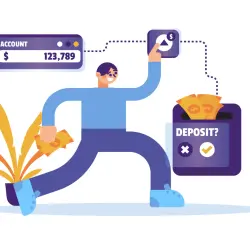Providing customers with convenient and secure payment methods is essential for any business, regardless of size. Although Zelle is a popular P2P payment platform, in this guide, we’ll show you how to set up Zelle for business purposes as well—so you and your customers can benefit from fast, low-cost transactions.
Setting Up Zelle for Business

Most businesses feel the impact of transaction fees on their profits. In a sea of payment processing options, one of the biggest advantages of using Zelle for business is its low-to-no-fee transactions.
Once you connect the platform to your business bank account, you can send and receive payments instantly—without hemorrhaging profit in the process.
Before setting up a Zelle business account, you’ll need to:
- Check whether your banking institution permits it. Not all banks that offer Zelle as a P2P service offer it for business use.
- Set up a business checking account with your financial institution and connect your merchant account. You cannot use Zelle for business with a personal or debit card account.
- Establish a phone number and email address for your business account that is different from your personal Zelle account. You cannot use the same email and phone number for both accounts.
- Check your financial institution’s transaction limits. Every bank is different, and it’s worth knowing whether the sending and receiving limits imposed by your bank will hinder cash flow or customer transactions.

How to Create a Zelle Business Account
In general, setting up Zelle for business requires the following steps. Note that the process might be slightly different depending on your financial institution.
- Log into your business bank account. If, for instance, you are using a Zelle Wells Fargo account, sign into your account on their website or mobile app.
- Click on “Send Money with Zelle,” which you will usually find under the “Pay & Transfer” tab in the main menu.
- To proceed, you’ll need to read and accept Zelle’s terms and conditions (Transfer Service Addendum).
- Navigate to “Manage Payment Profiles” under “Zelle Preferences.”
- Enroll in the US business phone number or email address that you want to use to accept payments. This makes it possible for you to receive business payments without sharing sensitive information—or even your account number.
- Select the business account number where you want to receive customer transactions. Payments made to you via Zelle will be deposited directly into this account.

How to Receive Money From Zelle
Now you’re ready to get paid! To send a payment request, select “Pay & Transfer: Zelle” in your banking app and then select “Request”. If your client is already saved in your recipients list, select their name. If not, you can add a recipient by clicking the plus sign. Enter the amount due, review your request, and click send.
Alternatively, you can simply provide your client with your enrolled email address or mobile number, and they can make the payment from their Zelle or banking app.
You will receive a notification via email or text once you have been paid, and the money will appear directly in the selected business bank account.
Pros and Cons of Zelle for Business
Although Zelle has some advantages for small- to medium-sized business owners, it also lacks some critical features that cater to growth for larger businesses.
Let’s dive further into some of the pros and cons of using Zelle for business to help you determine if Zelle is the right fit for your business.

Advantages of Zelle for Business
Speed and Ease
Zelle provides real-time money transfers, allowing instant access to funds. This eliminates the need for waiting periods and reduces cash flow problems.
Cost-Effectiveness
Zelle does not charge a transaction fee. Some banks may charge a small fee, but in most cases, Zelle is free to use.
Customer Convenience
By offering Zelle as a payment option, you provide your customers with a fast and secure way to make payments. This can lead to improved customer satisfaction and retention.

Disadvantages of Zelle for Business
Limited Banking Support
Not all banks support Zelle for business use. It’s essential to verify if your specific bank supports Zelle transactions before relying on it as your primary payment method.
Limited Payment Method for Customers
While Zelle allows fast, low-cost payments, your clients can only pay through the Zelle app or their banking app. Zelle does not integrate with eCommerce platforms and does not accept credit cards. If customers cannot pay in the way that is most convenient for them, they may go elsewhere.
Non-Refundable Transactions
Unlike some other payment methods, transactions made through Zelle are typically non-refundable. If a transaction is sent in error or if there is a dispute, it may be challenging to recover the funds. It’s crucial to exercise caution and verify payment details before completing transfers.
No Purchase Protection
Unlike some other payment platforms, Zelle does not offer purchase protection. If you get scammed, there’s a good chance you won’t get your money back.
Not Available Internationally
Zelle is only available within the United States. If you want to make or receive payments internationally, you will need to explore alternative options.
Streamline Payment Processing for Your Business and Your Customers
Zelle’s no-cost service seems ideal to maximize profits—but with no purchase protection and limited features, you could be restricting your business growth. Offering customers more payment options not only improves their experience but also enables you to expand across various sales mediums.
These days, business owners have low-cost payment options that can improve the customer experience and enable expansion. Whether you need to process credit card payments online, in person or over the phone, PaymentCloud can customize payment processing options to support your unique needs. As a merchant services provider for multiple industries including high-risk businesses, we offer competitive rates, advanced fraud protection, and hundreds of integration options to choose from!
Zelle Business Account Set up FAQs
Can you integrate Zelle with other accounting software?
Zelle does not integrate with any accounting software platforms. It also does not provide additional features or integrations for any business functions such as inventory management and gratuities.
Does Zelle share financial data with the IRS?
Zelle does not provide business owners with a 1099-K nor does it report transactions to the IRS.
How does Zelle stack up against other digital wallet options?
Zelle is technically not a digital wallet. Other payment platforms such as Venmo and PayPal offer a host of features and business benefits that Zelle does not; however, they also come at a cost. You can find a full breakdown of Zelle alternatives and tips for choosing the most suitable one for your business here.




